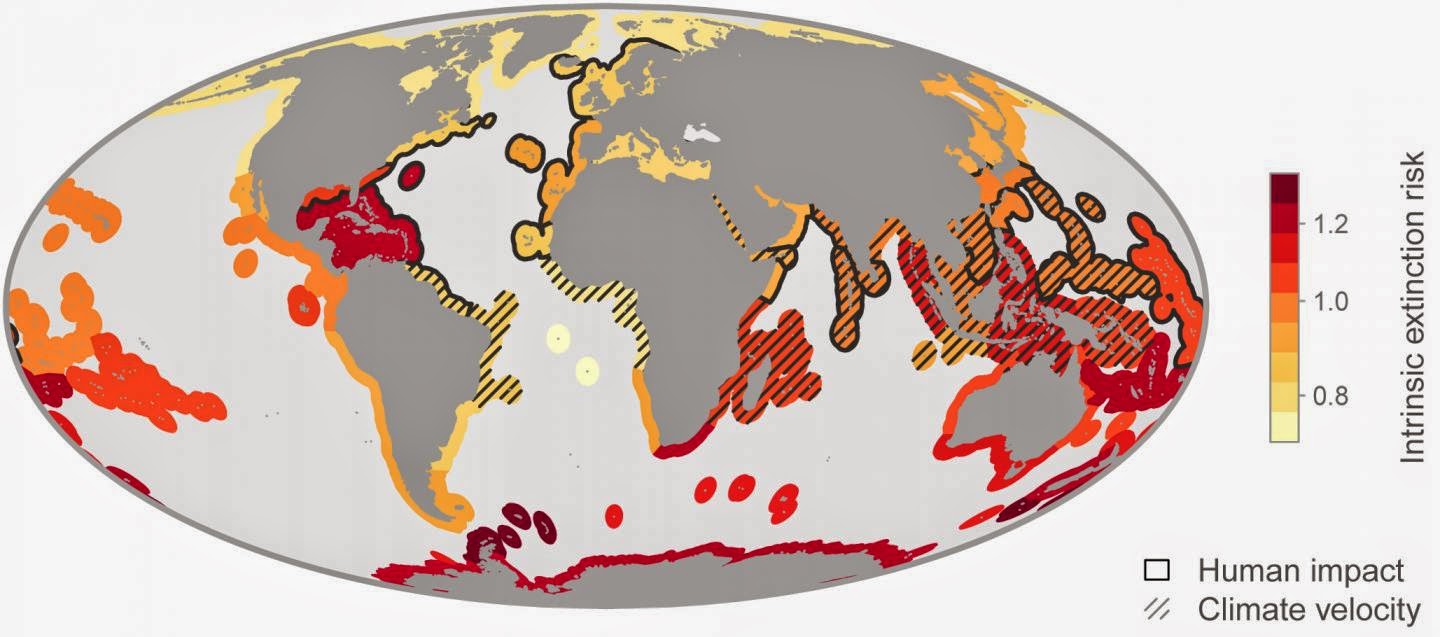
A detailed study of marine animals that died out over the past 23 million years can help identify which animals and ocean ecosystems may be most at risk of extinction today, according to an international team of paleontologists and ecologists.
In a paper to be published in the May 1 issue of the journal Science, researchers from the University of California, Berkeley, and other institutions report that worldwide patterns of extinction remained remarkably similar over this period, with the same groups of animals showing similar rates of extinction throughout and with a consistent set of characteristics associated with elevated extinction risk.
The researchers then used these past global extinction patterns as a baseline to predict which ocean areas and marine organisms would be most at risk today without the added threat of human-caused habitat destruction, overfishing, pollution and ocean acidification.
Finally, the authors combined this natural or ‘intrinsic’ extinction risk with current threats from humans and climate change to obtain a global map of potential future hotspots of extinction risk.
“Our goal was to diagnose which species are vulnerable in the modern world, using the past as a guide,” said lead author Seth Finnegan, an assistant professor of integrative biology at UC Berkeley. “We believe the past can inform the way we plan our conservation efforts. However, there is a lot more work that needs to be done to understand the causes underlying these patterns and their policy implications.”
“It’s very difficult to detect extinctions in the modern oceans, but fossils can help fill in the gaps,” added co-author and conservation biologist Sean Anderson, a postdoctoral researcher at Simon Fraser University in Burnaby, British Columbia. “Our findings can help prioritize areas and species that might be at greater risk of extinction and that might require extra attention, conservation or management.”
Marine extinctions with and without humans
The study found that animals with small geographic ranges are most at risk of extinction, Finnegan said. In addition, some groups tend to be more extinction-prone than others. For example, in the fossil record, whales, dolphins and seals show higher risk of extinction than sharks or invertebrates such as corals. Clams and mussels — so-called bivalves — had about one-tenth the extinction risk of mammals.
The authors used these patterns from the fossil record to assess the natural extinction risk of animals living in the oceans today. Comparing these patterns with areas where human activities such as fishing impact the oceans revealed areas that may be particularly sensitive. These areas included high- biodiversity regions of the tropics such as the Indo-Pacific and the Caribbean, as well as regions such as Antarctica that harbor many unique species.
“The implications of these patterns for the future of coastal marine ecosystems will depend on how natural risk and current threats interact,” said co-author Paul Harnik, an assistant professor of geosciences at Franklin and Marshall College in Lancaster, Pennsylvania. “”By understanding these patterns in the past, we hope to provide a framework for understanding global change.”
Bridging the gap
The analysis grew out of a series of meetings at the National Evolutionary Synthesis Center in Durham, North Carolina, which is funded by the National Science Foundation. The team agreed on the need to bridge the gap between the fossil record of marine animal extinction and what modern-day biologists are finding as they explore living ocean ecosystems.
The group focused on the past 23 million years when the planet looked largely the same as today: The continents were arranged similarly, and most of the same major taxonomic groups, from whales and seals to clams, snails and sea urchins, existed. However, this time interval encompassed dramatic changes in Earth’s climate. The group determined that patterns of extinction risk were consistent despite this variability — suggesting that the fossil record can provide a valuable pre-human baseline for considering current threats to marine biodiversity.
“Climate change and human activities are impacting groups of animals that have a long history, and studying that history can help us condition our expectations for how they might respond today,” Finnegan said.
Note : The above story is based on materials provided by University of California – Berkeley.










